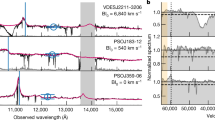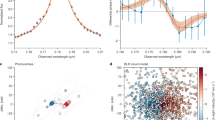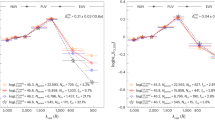Abstract
Both theory and observations suggest that outflows driven by an active central supermassive black hole have a feedback effect on shaping the global properties of the host galaxy1,2,3,4,5,6,7,8. However, whether feedback from the outflow is effective, and if so, whether it is positive or negative, have long been controversial. Here, using the latest catalogue from the Sloan Digital Sky Survey, we use the flux ratio of the [O ii] to [Ne v] emission lines as a proxy to compare the star formation rate in the hosts of quasars with different types of broad absorption lines (BALs): low-ionization (Lo)BAL, high-ionization (Hi)BAL and non-BAL. We find that the star formation rate decreases from LoBAL to HiBAL quasars, and then increases from HiBAL to non-BAL quasars. Assuming that the sequence of LoBAL to HiBAL to non-BAL represents evolution, our results are consistent with a quenching and subsequent rebound of star formation in quasar host galaxies. This phenomenon can be explained by suppression of the star formation rate by the outflow and then rebound of the rate once the outflow disappears as the quasars evolve from HiBALs to non-BALs. Our result suggests that the quasar outflow has a negative global feedback on galaxy evolution.
This is a preview of subscription content, access via your institution
Access options
Access Nature and 54 other Nature Portfolio journals
Get Nature+, our best-value online-access subscription
$29.99 / 30 days
cancel any time
Subscribe to this journal
Receive 12 digital issues and online access to articles
$119.00 per year
only $9.92 per issue
Buy this article
- Purchase on Springer Link
- Instant access to full article PDF
Prices may be subject to local taxes which are calculated during checkout


Similar content being viewed by others
Data availability
The datasets that support the figures within this paper are available as Supplementary Data. The SDSS sample data for different types of quasars in this work are available at http://staff.ustc.edu.cn/z̃cho/sample.html. Any additional data are available from the corresponding author. Source data are provided with this paper.
Code availability
The codes that support the figures within this paper and other findings of this study are available from the corresponding author.
References
Silk, J. & Rees, M. J. Quasars and galaxy formation. Astron. Astrophys. 331, L1–L4 (1998).
Kauffmann, G. & Haehnelt, M. A unified model for the evolution of galaxies and quasars. Mon. Not. R. Astron. Soc. 311, 576–588 (2000).
Di Matteo, T., Springel, V. & Hernquist, L. Energy input from quasars regulates the growth and activity of black holes and their host galaxies. Nature 433, 604–607 (2005).
Hopkins, P. F. et al. A unified, merger-driven model of the origin of starbursts, quasars, the cosmic X-ray background, supermassive black holes, and galaxy spheroids. Astrophys. J. Suppl. Ser. 163, 1–49 (2006).
Fabian, A. C. Observational evidence of active galactic nuclei feedback. Annu. Rev. Astron. Astrophys. 50, 455–489 (2012).
Zubovas, K. & King, A. Clearing out a galaxy. Astrophys. J. Lett. 745, L34 (2012).
Heckman, T. M. & Best, P. N. The coevolution of galaxies and supermassive black holes: insights from surveys of the contemporary Universe. Annu. Rev. Astron. Astrophys. 52, 589–660 (2014).
He, Z. et al. The properties of broad absorption line outflows based on a large sample of quasars. Nat. Astron. 3, 265–271 (2019).
Gibson, R. R. et al. A catalog of broad absorption line quasars in Sloan Digital Sky Survey Data Release 5. Astrophys. J. 692, 758–777 (2009).
Allen, J. T., Hewett, P. C., Maddox, N., Richards, G. T. & Belokurov, V. A strong redshift dependence of the broad absorption line quasar fraction. Mon. Not. R. Astron. Soc. 410, 860–884 (2011).
Urry, C. M. & Padovani, P. Unified schemes for radio-loud active galactic nuclei. Publ. Astron. Soc. Pac. 107, 803 (1995).
Boroson, T. A. Evidence against some orientation effects in radio-quiet quasars. Astrophys. J. Lett. 399, L15 (1992).
Hall, P. B. et al. Unusual broad absorption line quasars from the Sloan Digital Sky Survey. Astrophys. J. Suppl. Ser. 141, 267 (2002).
Wang, T., Ferland, G. J., Yang, C., Wang, H. & Zhang, S. Evidence for fluorescent Fe ii emission from extended low ionization outflows in obscured quasars. Astrophys. J. 824, 106 (2016).
Trump, J. R. et al. A catalog of broad absorption line quasars from the Sloan Digital Sky Survey Third Data Release. Astrophys. J. Suppl. Ser. 165, 1–18 (2006).
Dai, X., Shankar, F. & Sivakoff, G. R. The intrinsic fractions and radio properties of low-ionization broad absorption line quasars. Astrophys. J. 757, 180 (2012).
Zhang, S. et al. Low-z Mg ii broad absorption-line quasars from the Sloan Digital Sky Survey. Astrophys. J. 714, 367–383 (2010).
Lyke, B. W. et al. The Sloan Digital Sky Survey quasar catalog: Sixteenth Data Release. Astrophys. J. Suppl. Ser. 250, 8 (2020).
York, D. G. et al. Average extinction curves and relative abundances for quasi-stellar object absorption-line systems at 1 ≤ zabs < 2. Mon. Not. R. Astron. Soc. 367, 945–978 (2006).
Ho, L. C. [O ii] emission in quasar host galaxies: evidence for a suppressed star formation efficiency. Astrophys. J. 629, 680 (2005).
Maddox, N. [O ii] as a proxy for star formation in AGN host galaxies: beware of extended emission line regions. Mon. Not. R. Astron. Soc. 480, 5203–5210 (2018).
Willott, C. J., Rawlings, S. & Grimes, J. A. The submillimeter properties of broad absorption line quasars. Astrophys. J. 598, 909–915 (2003).
Priddey, R. S. et al. A sensitive submillimetre survey of broad absorption-line quasars. Mon. Not. R. Astron. Soc. 374, 867–876 (2007).
Boroson, T. A. & Meyers, K. A. The optical properties of IR-selected and Mg ii broad absorption line quasars. Astrophys. J. 397, 442–451 (1992).
Zhang, S. et al. Low-z Mg ii broad absorption-line quasars from the Sloan Digital Sky Survey. Astrophys. J. 714, 367–383 (2010).
Zhuang, M.-Y. & Ho, L. C. Recalibration of [O ii] λ3727 as a star formation rate estimator for active and inactive galaxies. Astrophys. J. 882, 89 (2019).
Allen, M. G., Groves, B. A., Dopita, M. A., Sutherland, R. S. & Kewley, L. J. The MAPPINGS III library of fast radiative shock models. Astrophys. J. Suppl. Ser. 178, 20–55 (2008).
Hopkins, P. F. et al. A physical model for the origin of quasar lifetimes. Astrophys. J. Lett. 625, L71–L74 (2005).
Urrutia, T. et al. The FIRST-2MASS Red Quasar Survey II: an anomalously high fraction of LoBALs in searches for dust-reddened quasars. Astrophys. J. 698, 1095–1109 (2009).
Tombesi, F. et al. Wind from the black-hole accretion disk driving a molecular outflow in an active galaxy. Nature 519, 436–438 (2015).
Feruglio, C. et al. The multi-phase winds of Markarian 231: from the hot, nuclear, ultra-fast wind to the galaxy-scale, molecular outflow. Astron. Astrophys. 583, A99 (2015).
Laha, S. et al. Ionized outflows from active galactic nuclei as the essential elements of feedback. Nat. Astron. 5, 13–24 (2021).
Arav, N. et al. Evidence that 50% of BALQSO outflows are situated at least 100 pc from the central source. Astrophys. J. 857, 60 (2018).
Abazajian, K. N. et al. The Seventh Data Release of the Sloan Digital Sky Survey. Astrophys. J. Suppl. Ser. 182, 543–558 (2009).
Smee, S. A. et al. The multi-object, fiber-fed spectrographs for the Sloan Digital Sky Survey and the Baryon Oscillation Spectroscopic Survey. Astron. J. 146, 32 (2013).
Dawson, K. S. et al. The Baryon Oscillation Spectroscopic Survey of SDSS-III. Astron. J. 145, 10 (2013).
Dawson, K. S. et al. The SDSS-IV Extended Baryon Oscillation Spectroscopic Survey: overview and early data. Astron. J. 151, 44 (2016).
Vestergaard, M. & Wilkes, B. J. An empirical ultraviolet template for iron emission in quasars as derived from I Zwicky 1. Astrophys. J. Suppl. Ser. 134, 1–33 (2001).
Véron-Cetty, M.-P., Joly, M. & Véron, P. The unusual emission line spectrum of I Zw 1. Astron. Astrophys. 417, 515–525 (2004).
Weymann, R. J., Morris, S. L., Foltz, C. B. & Hewett, P. C. Comparisons of the emission-line and continuum properties of broad absorption line and normal quasi-stellar objects. Astrophys. J. 373, 23 (1991).
Shen, Y. & Ménard, B. On the link between associated Mg ii absorbers and star formation in quasar hosts. Astrophys. J. 748, 131 (2012).
Chen, Z.-F. et al. The reddening and [O ii] emissions of the quasar Mg ii absorption-line systems. Astrophys. J. 893, 25 (2020).
Prevot, M. L., Lequeux, J., Maurice, E., Prevot, L. & Rocca-Volmerange, B. The typical interstellar extinction in the Small Magellanic Cloud. Astron. Astrophys. 132, 389–392 (1984).
Pei, Y. C. Interstellar dust from the Milky Way to the Magellanic Clouds. Astrophys. J. 395, 130 (1992).
Richards, G. T. et al. Red and reddened quasars in the Sloan Digital Sky Survey. Astron. J. 126, 1131–1147 (2003).
Baldwin, J. A. Luminosity indicators in the spectra of quasi-stellar objects. Astrophys. J. 214, 679–684 (1977).
Zhang, K., Wang, T.-G., Gaskell, C. M. & Dong, X.-B. The Baldwin effect in the narrow emission lines of active galactic nuclei. Astrophys. J. 762, 51 (2013).
Schulze, A. et al. Near-IR spectroscopy of luminous LoBAL quasars at 1 < z < 2.5. Astrophys. J. 848, 104 (2017).
Brinchmann, J. et al. The physical properties of star-forming galaxies in the low-redshift Universe. Mon. Not. R. Astron. Soc. 351, 1151–1179 (2004).
Daddi, E. et al. Multiwavelength study of massive galaxies at z ~ 2. I. Star formation and galaxy growth. Astrophys. J. 670, 156–172 (2007).
Xie, Y., Ho, L. C., Zhuang, M.-Y. & Shangguan, J. The infrared emission and vigorous star formation of low-redshift quasars. Astrophys. J. 910, 124 (2021).
Kormendy, J. & Ho, L. C. Coevolution (or not) of supermassive black holes and host galaxies. Annu. Rev. Astron. Astrophys. 51, 511–653 (2013).
Greene, J. E., Strader, J. & Ho, L. C. Intermediate-mass black holes. Annu. Rev. Astron. Astrophys. 58, 257–312 (2020).
Chen, Z.-F. et al. Quasar properties from the Sloan Digital Sky Survey. II. The quasars obtained by the SDSS-IV in the first two years. Astrophys. J. Suppl. Ser. 244, 36 (2019).
Acknowledgements
Z.C. is supported by the National Natural Science Foundation of China (12073007), the Guangxi Natural Science Foundation (2019GXNSFFA245008, GKAD19245136 and 2018GXNSFAA050001), the National Natural Science Foundation of China (11763001) and the Scientific Research Project of Guangxi University for Nationalities (2018KJQD01). Z.H. is supported by NSFC-11903031 and 12192221 and USTC Research Funds of the Double First-Class Initiative YD 3440002001. L.C.H. is supported by the National Science Foundation of China (11721303 and 11991052) and the National Key R&D Program of China (2016YFA0400702). Funding for the Sloan Digital Sky Survey IV has been provided by the Alfred P. Sloan Foundation, the U.S. Department of Energy Office of Science, and the Participating Institutions. SDSS-IV acknowledges support and resources from the Center for High Performance Computing at the University of Utah. The SDSS website is http://www.sdss.org. SDSS-IV is managed by the Astrophysical Research Consortium for the Participating Institutions of the SDSS Collaboration including the Brazilian Participation Group, the Carnegie Institution for Science, Carnegie Mellon University, Center for Astrophysics ∣ Harvard & Smithsonian, the Chilean Participation Group, the French Participation Group, Instituto de Astrofísica de Canarias, The Johns Hopkins University, Kavli Institute for the Physics and Mathematics of the Universe (IPMU)/University of Tokyo, the Korean Participation Group, Lawrence Berkeley National Laboratory, Leibniz Institut für Astrophysik Potsdam (AIP), Max-Planck-Institut für Astronomie (MPIA Heidelberg), Max-Planck-Institut für Astrophysik (MPA Garching), Max-Planck-Institut für Extraterrestrische Physik (MPE), National Astronomical Observatories of China, New Mexico State University, New York University, University of Notre Dame, Observatário Nacional/MCTI, The Ohio State University, Pennsylvania State University, Shanghai Astronomical Observatory, United Kingdom Participation Group, Universidad Nacional Autónoma de México, University of Arizona, University of Colorado Boulder, University of Oxford, University of Portsmouth, University of Utah, University of Virginia, University of Washington, University of Wisconsin, Vanderbilt University and Yale University.
Author information
Authors and Affiliations
Contributions
Z.C. made the calculations, wrote the manuscript and comprehensively discussed the idea. Z.H. presented the idea, discussed the calculations and wrote the main text of the manuscript. L.C.H. oversaw and revised the whole manuscript. Q.G., T.W. and M.Z. discussed the idea and calculations. G.L. and Z.W. gave comments on the revision of the manuscript. All authors discussed and gave comments on the contents of the paper.
Corresponding author
Ethics declarations
Competing interests
The authors declare no competing interests.
Peer review information
Nature Astronomy thanks Jonathan Trump and the other, anonymous, reviewer(s) for their contribution to the peer review of this work.
Additional information
Publisher’s note Springer Nature remains neutral with regard to jurisdictional claims in published maps and institutional affiliations.
Extended data
Extended Data Fig. 1 The composite spectra after reddening corrections.
Using the Small Magellanic Cloud extinction curve with AV = 0.088 mag for the HiBALs (blue line) and 0.417 mag for the LoBALs (red line).
Extended Data Fig. 2 The variation of line ratio R = EW[O II]/EW[Ne v] as quasars evolve for different black hole masses.
The line ratio R significantly decreases and then increases as quasars evolve from LoBALs to HiBALs to non-BALs, for each of the three bins of black hole masses. The vertical error bars mark the 1σ uncertainty of the line ratio.
Supplementary information
Supplementary Information
Supplementary Table 1 and Figs. 1–7.
Source data
Source Data Fig. 1
The median composite spectra of three types of quasars.
Source Data Fig. 2
The line ratio at different phases of quasar evolution.
Source Data Extended Data Fig. 1
The composite spectra after reddening corrections.
Source Data Extended Data Fig. 2
The line ratio for quasar with different black hole masses.
Rights and permissions
About this article
Cite this article
Chen, Z., He, Z., Ho, L.C. et al. Evidence for the connection between star formation rate and the evolutionary phases of quasars. Nat Astron 6, 339–343 (2022). https://doi.org/10.1038/s41550-021-01561-3
Received:
Accepted:
Published:
Issue Date:
DOI: https://doi.org/10.1038/s41550-021-01561-3



